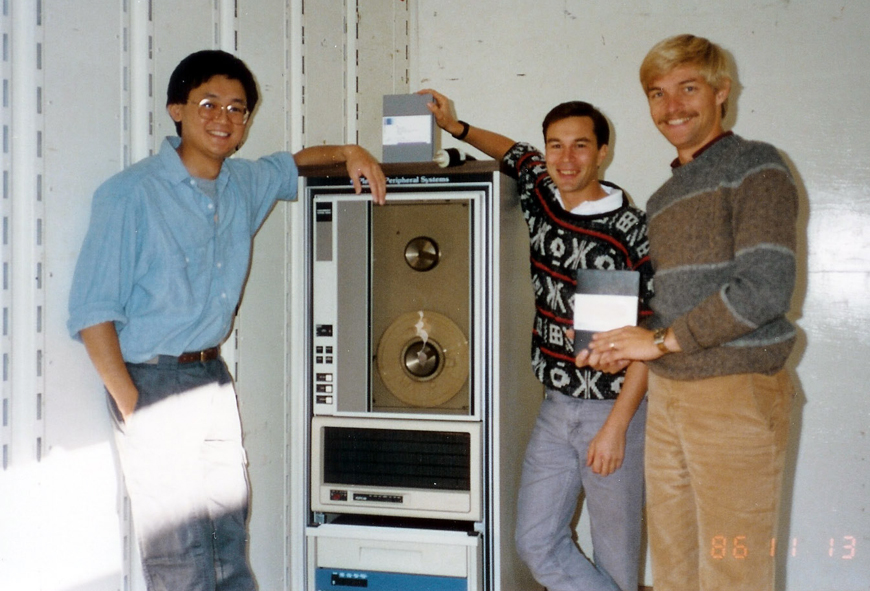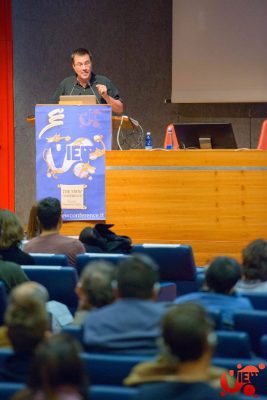Glenn Entis is one of the original founders of Pacific Data Images, along with Carl Rosendahl (who established the company in 1980) and Richard Chuang. The trio of course pioneered computer animation during the 80s and 90s, and launched into feature films with Antz in 1995 via a deal with DreamWorks. PDI later became part of DreamWorks and would go on to make Shrek and many other films, but sadly PDI/DreamWorks was shuttered in January this year. Entis recently spoke at the VIEW Conference in Italy, and fxguide caught up with him to discuss the early days at PDI where he helped develop the PDI Animation System (for which he and the company’s co-founders won a SciTech Technical Achievement Award in 1998).
fxg: We heard from Richard Chuang a couple of years ago that PDI had still been using the animation you had developed until around 2012 – does that surprise you?
Entis: I had heard that. I had visited them around 10 years after I left. There was an amazing engineer there, Drew Olbrich. I hadn’t seen him for years and he saw I was visiting and he called me over and it was like I’d never left. He said, Glenn I want to show you something. And he showed me some new software he was working on which was amazing. He showed me about 3 or 4 minutes of this demo and then he said your e-nodes are at the center of all of this. I was so touched, because that e-node system I programmed up in 1983. It’s an unusual data structure but what it allowed us to do was to compile our scripts into an immediate code that we could run on an interpreter basis. Then we could run all our interactive tools and decompile it back to script. It gave us this incredible flexibility because as we developed more and more interactive tools you could always back and if you wanted to hand-code things you always got back a source code version of anything you did, which was due to these e-nodes. I would have said at the time that it would last five years or so, but it was almost 30 years in production.

fxg: As time went on there must have been other animation systems around – did you look to these for adoption or inspiration?
Entis: Yes, we looked at everything. You know, a pretty heavy inertial sets in when you have software. The more time you spend with a piece of software, the more people are comfortable with it – they’ve learned it and the cost of changing it is harder. But we were always looking at stuff. I actually wrote two animation software pieces – it was more or less the same language. I wrote the animation language in 1983 and the associated animation software and some of the modeling tools, Richard wrote some of the other modeling tools. I also wrote the renderer up until the scanline, and then Richard did all the hard part in the scanline for the renderer. He had a signal processing background and really did the hard part. But I wrote the animation language twice, the first time I was really influenced by Craig Reynolds who had published a paper a year or two before just called SCRIPT.
I really liked the simplicity and clarity of how he took programming constructs that were already well known, but made just enough changes to make them really native and convenient for computer graphics processes. I didn’t copy that verbatim, but was heavily influenced by it. I then wrote my own compiler. You would basically compile the language and create the graphics. That worked fine for a bunch of stuff, but it didn’t give us the two way communication for the interactive tools.
Later I extended the language and completely re-wrote it with this E-node structure at the center, and that gave me a digital format that we could run on an interpreter basis – it could run very fast actually, but you could always decompile back to the source code.

fxg: I imagine Wavefront or Alias’ systems would have been of interest too?
Entis: Yes, I’d go up to Montreal and made good friends with Wavefront, Softimage and Alias – before they all merged. They’d fly out to see us too. In fact, in about 1992 we bought several Softimage licences. There were many things they did better than us, but some of the things we felt were unique to our studio and defined our look were difficult or impossible to do in that software. We’d say, Oh they’ve got better interactive modeling tools, but then we’d look at their lighting tools and say, Oh my gosh they’re awful compared to what we have. At that time, some of the ways they dealt with compositing wasn’t great, and although ours was pretty labor-intensive, it was incredibly flexible and powerful. So we were worried about just being like everybody else and losing the things that make us who we are.
fxg: And in a similar way PDI also had its own approach to lighting, with spreadsheets wasn’t it?
Entis: Well, it was spreadsheets originally. Richard developed a tool called led, which was brilliant. It was probably the first and best tool that gave you near-realtime feedback on lighting. He did some very clever things. We looked around and at the time we didn’t see or hear anybody who was able to give lighters faster, better feedback than led.
fxg: It’s interesting, isn’t it – there was so much going on at this time in the early 90s in terms of computer animation with PDI, Rhythm & Hues, Blue Sky and of course Pixar.
Entis: I also think that the perceived dominance of Pixar at the time time is largely deserved. One very concrete example is that my first computer graphics teacher was Ed Catmull. When he was at the New York Institute of Technology, I took his level one class on computer graphics in the Fall of 1977. I took level two in the Spring of 1979 and in the Summer of ’79, he and I both moved out to California, him to go to Lucasfilm and me to Hewlett-Packard. Then when I was hired at Ampex, I had been hired by Tom Porter to take over his code base. And he had come from NYIT, so there was a diaspora of NYIT people who all did their time at other places and then re-formed at Lucasfilm, and then went to Pixar.
We all studied the papers that Pixar wrote, we were all inspired by them. I met John Lasseter in 1984 and immediately became friends with him. He was a groomsman at my wedding and I was at his wedding. We’re still friends. I think a debt to Pixar is well-deserved, but other companies of course had very bright people and were also innovating and doing new and different things. There was amazing work being done at Blue Sky and at Rhythm & Hues.
fxg: Was getting into feature films always the goal at PDI?
Entis: It was our long-term goal. We made a 10 year plan. When we could get animation down below a certain cost per second, when we have our first character animation piece that told a story, when we would get our first TV commercial, when we’d be able to do our first TV special, when we could do a TV series…and then a feature film. We laid it out on a 10 year schedule. The value of that exercise is that we were wrong about all the details but we were right about the overall shape of the envelope, and what it helped us do was create a framework in which we could evaluate advances in the business, new tools, new software.
fxg: When you left PDI, you worked at DreamWorks Interactive and EA – what have you been up to since then?
Entis: I left EA in 2008, where I had been a Chief Technical Office of their Worldwide Studios. We had almost 1500 engineers and 1500 artists worldwide. It was a tremendous experience, a lot of fun, but when I left I wasn’t sure what I wanted to do in the games industry. But with my boss Paul Lee who also left at the same time, we started a venture capital fund in Vancouver called Vanedge Capital. We raised almost $140m dollars, right after the crash too, when it was a tough time to raise money. I was a general partner there for a couple of years. It was one of the few jobs I had where I didn’t love it. I liked it OK, but I realized my heart wasn’t in it, partly because I would be meeting teams, getting to know the team, their product and their plan and then saying ‘No’. A good VC fund invests in only a tiny percentage of companies. VC funds don’t like risk – they hate risk. They’ll make riskier investments than other types of firms, but it’s not because they like risk. Now I do some consulting for EA, some of Zynga but my day job is I’m retired!
